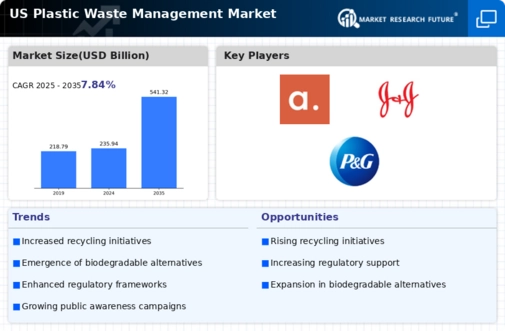Corporate Sustainability Goals
Many corporations are increasingly adopting sustainability goals, which significantly impacts the plastic waste-management market. Companies are setting ambitious targets to reduce their plastic footprint, often committing to recycling a substantial portion of their plastic waste. For example, major brands have pledged to make their packaging recyclable or reusable by 2025. This corporate shift is driving demand for innovative waste-management solutions, as businesses seek partnerships with recycling firms to meet their sustainability objectives. The plastic waste-management market is likely to benefit from this trend, as companies invest in technologies that facilitate efficient waste processing and recycling.
Increased Environmental Awareness
The growing consciousness regarding environmental issues among consumers and businesses is a pivotal driver for the plastic waste-management market. As awareness of plastic pollution escalates, stakeholders are increasingly seeking effective waste-management solutions. This shift is reflected in the rising demand for recycling services and sustainable practices. According to recent data, approximately 75% of Americans express concern about plastic waste, prompting companies to adopt eco-friendly initiatives. This trend not only influences consumer behavior but also compels businesses to invest in innovative waste-management technologies. Consequently, the plastic waste-management market is likely to experience substantial growth as organizations strive to align with environmentally responsible practices.
Government Initiatives and Funding
Government initiatives aimed at reducing plastic waste play a crucial role in shaping the plastic waste-management market. Various federal and state programs are being implemented to promote recycling and waste reduction. For instance, the U.S. government has allocated over $1 billion in funding for waste-management projects, which includes enhancing recycling infrastructure. These initiatives encourage local governments and private entities to develop efficient waste-management systems. As a result, the market is witnessing an influx of investments in advanced recycling technologies and facilities. This governmental support not only boosts the market but also fosters collaboration between public and private sectors to tackle plastic waste effectively.
Rising Demand for Circular Economy Practices
The increasing emphasis on circular economy practices is a significant driver for the plastic waste-management market. Businesses and consumers are recognizing the importance of reusing and recycling materials to minimize waste. This shift towards a circular economy encourages the development of systems that facilitate the recycling and repurposing of plastic products. According to recent studies, the circular economy could potentially reduce plastic waste by up to 50% in the coming years. As a result, the plastic waste-management market is likely to see a surge in demand for services and technologies that support circular economy initiatives, fostering a more sustainable approach to plastic use.
Technological Innovations in Waste Processing
Technological advancements in waste processing are transforming the plastic waste-management market. Innovations such as advanced sorting technologies, chemical recycling, and waste-to-energy systems are enhancing the efficiency of waste management. For instance, the introduction of AI-driven sorting systems has improved the accuracy of recycling processes, leading to higher recovery rates of recyclable materials. This technological evolution not only streamlines operations but also reduces costs associated with waste management. As these technologies become more accessible, the plastic waste-management market is expected to expand, driven by the need for more effective and sustainable waste processing solutions.














Leave a Comment